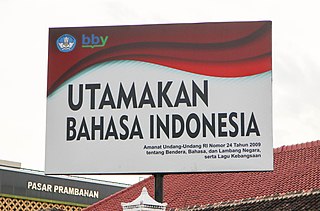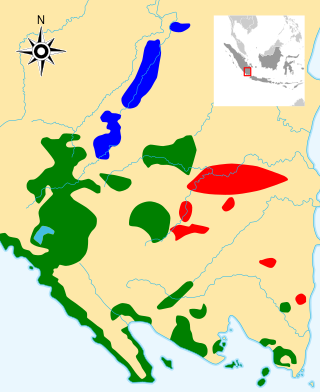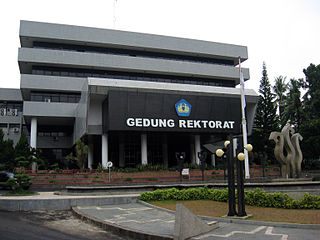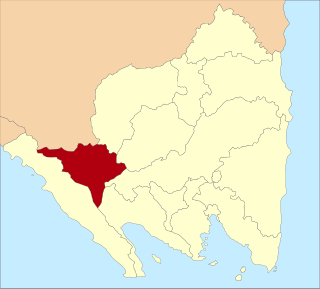Related Research Articles

Banten is the westernmost province on the island of Java, Indonesia. Its capital city is Serang and its largest city is in Tangerang. The province borders West Java and the Special Capital Region of Jakarta on the east, the Java Sea on the north, the Indian Ocean on the south, and the Sunda Strait on the west and shares a maritime border with Bengkulu and Lampung to the east and Bangka Belitung Islands to the north. The province covers an area of 9,662.82 km2 (3,730.84 sq mi). It had a population of over 11.9 million in the 2020 census, up from about 10.6 million in 2010. The estimated mid-2022 population was 12.25 million. Formerly part of the province of West Java, Banten become a province in 2000. The northern half has recently experienced rapid rises in population and urbanization, and the southern half has a more traditional character but an equally fast-rising population.

The Dayak or Dyak or Dayuh are one of the native groups of Borneo. It is a loose term for over 200 riverine and hill-dwelling ethnic groups, located principally in the central and southern interior of Borneo, each with its own dialect, customs, laws, territory, and culture, although common distinguishing traits are readily identifiable. Dayak languages are categorised as part of the Austronesian languages. The Dayak were animist in belief; however, since the 19th century there has been mass conversion to Christianity as well as Islam due to the spreading of Abrahamic religions.

South Sumatra is a province of Indonesia, located on the southeast of the island of Sumatra. The capital and largest city of the province is the city of Palembang. The province borders the provinces of Jambi to the north, Bengkulu to the west and Lampung to the south, as well a maritime border with the Bangka Belitung Islands to the east. It is the largest province in the island of Sumatra, and it is slightly larger than Hungary. The Bangka Strait in the east separates South Sumatra and the island of Bangka, which is part of the Bangka Belitung Islands province. The province has an area of 91,592.43 km2 (35,364 sq mi) and has a population of 8,467,432 at the 2020 Census; the official estimate as at mid-2022 was 8,657,008. The province is rich in natural resources, such as petroleum, natural gas and coal. The province is inhabited by many different ethnic groups, with Palembangese being largest ethnic group. Most speak the Palembang language, which is mutually intelligible to both Indonesian and local Palembang Malay. Other ethnic groups include the Javanese, Sundanese, Minangkabau and Chinese. Most are concentrated in urban areas and are largely immigrants from other parts of Indonesia.

Bandar Lampung is the capital and largest city of the Indonesian province of Lampung. Located on the southern tip of Sumatra, Bandar Lampung was originally called Tanjungkarang–Telukbetung, since it was a unification of two major settlements in Lampung, before being renamed in 1983.

More than 700 living languages are spoken in Indonesia. This figure indicates that Indonesia has about 10% of the world's languages, establishing its reputation as the second most linguistically diverse nation in the world after Papua New Guinea. Most languages belong to the Austronesian language family, while there are over 270 Papuan languages spoken in eastern Indonesia. The language most widely spoken as a native language is Javanese.

Lampung or Lampungic is an Austronesian language or dialect cluster with around 1.5 million native speakers, who primarily belong to the Lampung ethnic group of southern Sumatra, Indonesia. It is divided into two or three varieties: Lampung Api, Lampung Nyo, and Komering. The latter is sometimes included in Lampung Api, sometimes treated as an entirely separate language. Komering people see themselves as ethnically separate from, but related to, Lampung people.

Pugung Raharjo is a 30 hectares archaeological site in the regency of East Lampung regency of Lampung Province in South Sumatra in Indonesia. The site was discovered in 1957. There is an ancient terraced megalithic structure, also known as Pugung Raharjo Pyramid. There other megalithic structures from the 12th to 16th century CE, including Menhirs and Dolmen, as well as prehistoric remains dating back to 2500 BC. It is locally known as the "Taman Purbakala Pugung Raharjo". It is situated approximately 50 km from the provincial capital, Bandar Lampung.

The Bantenese people are an indigenous ethnic group native to Banten in the westernmost part of Java island, Indonesia. The area of Banten province corresponds more or less with the area of the former Banten Sultanate, a Bantenese nation state that preceded Indonesia. In his book "The Sultanate of Banten", Guillot Claude writes on page 35: “These estates, owned by the Bantenese of Chinese descent, were concentrated around the village of Kelapadua.” Most of Bantenese are Sunni Muslim. The Bantenese speak the Bantenese language, a variety of the Sundanese language which does not have a general linguistic register, this language is called Basa Sunda Banten.
The Ulu scripts, locally known as Surat Ulu are a family of writing systems found in central and south Sumatra, in the regions of Kerinci, Bengkulu, Palembang and Lampung, Indonesia. They were used to write manuscripts in Sumatran languages and Malay, such as the Tanjung Tanah Code of Law. The Malay writing was gradually replaced by the Jawi script, a localized version of the Arabic script.
The Tumi is the sacrificial ceremonial knife used by the Incas and pre-Inca civilizations.

Lampung University is a public university in Bandar Lampung, Lampung, Indonesia. It was established on September 22, 1965. Its rector is Prof. Dr. Ir. Lusmeilia Afriani, D.E.A. IPM.

West Lampung Regency is a regency of Lampung Province, Sumatra, Indonesia. Until 2012 it had an area of 4,950.4 km2 of which forests occupied some 57% of the total area. It had a population of 418,560 people at the 2010 census. However, on 25 October 2012 the southwestern part of this area was separated from West Lampung Regency to form the new Pesisir Barat Regency.

Tulang Bawang Regency is a regency (kabupaten) of Lampung Province, Sumatra, Indonesia. The regency was created on 3 January 1997 from the eastern half of North Lampung Regency; when created, it originally covered a much wider area, but on 29 October 2008 the 7 northern districts were separated off to form a new Mesuji Regency, and the 8 western districts were also separated off to form a new West Tulang Bawang Regency. It now has an area of 3,466.32 square kilometres (1,338.35 sq mi) and had a population of 430,021 at the 2020 Census; the official estimate as at mid 2022 was 431,208. The regency seat is the town of Menggala, located about 120 kilometres (75 mi) from the provincial capital of Bandar Lampung. The regency takes its name from the Tulang Bawang River which flows through the province.

Pesisir Barat Regency is a new regency in Lampung Province of Indonesia. It was created on 25 October 2012 from the eight western districts of West Lampung Regency. It covers an area of 2,907.23 km2, and had a population of 141,741 at the 2010 Census and 162,697 at the 2020 Census; the official estimate as of mid-2022 was 164,816. The administrative center is the town of Krui. The majority group in the Pesisir Barat Regency is the Lampung people.
Liwa is the capital of West Lampung Regency, Lampung province, Indonesia.

The Lampung or Lampungese are an indigenous ethnic group native to Lampung and some parts of South Sumatra, Bengkulu, as well as in the southwest coast of Banten. They speak the Lampung language, a Lampungic language estimated to have 1.5 million speakers.

Sambal is an Indonesian chilli sauce or paste, typically made from a mixture of a variety of chilli peppers with secondary ingredients such as shrimp paste, garlic, ginger, shallot, scallion, palm sugar, and lime juice. Sambal is an Indonesian loanword of Javanese origin. It originated from the culinary traditions of Indonesia and is also an integral part of the cuisines of Singapore, Malaysia, Brunei, and Sri Lanka. It has also spread through overseas Indonesian populations to the Netherlands and Suriname.

Melinting is one of the traditional Lampungese dances originating from the Lampung province, Indonesia. The Melinting dance was originally called the Cetik Kipas dance. The name was later replaced with the Melinting dance which refers to the origin of this dance, namely the Melinting area. The name change was at the suggestion of President Sukarno who asked the Central Lampung Regional Government to perform the dance at Istora Senayan Jakarta on August 17, 1965. Melinting is a dance inherited from Ratu Melinting which is estimated to have existed in the sixteenth century. This dance is performed at traditional events when welcoming guests, and the dancers are members of the Queen's family or Melinting nobles. This dance was danced outside a traditional event for the first time in 1930 in Teluk Betung at the invitation of the Resident of Lampung to Pesirah Marga in Lampung.
Lembak people, also known as Linggau people, are a local ethnic group that inhabits several areas of Bengkulu Province and South Sumatra Province in Indonesia. Their original settlements are in the border area between the two provinces, in the Barisan mountain range, with densely clustered villages pattern.
Tumi is ancient tribe who are believed to be the ancestors of today's Lampung people. The Tumi people probably came from South India who came to Nusantara several millennia BC. The Tumi tribe used to live in the area around the slopes of Mount Pesagi and Lake Ranau in West Lampung Regency.
References
- 1 2 3 Sudjarwo, Prof. Dr. KPL Menjawab Sejarah (in Indonesian) (1 ed.). Lampung: Masa Kini Mandiri. p. 13. ISBN 9786025270529.
- ↑ Renaldy, Rustam (Sep 12, 2019). "Cikal Bakal Suku Lampung dalam Sejarah Singkat Kerajaan Sekala Brak" . Retrieved Aug 7, 2023.